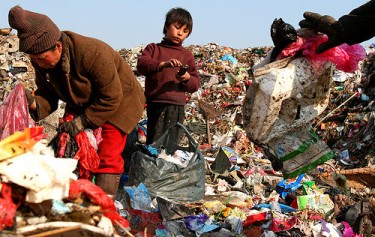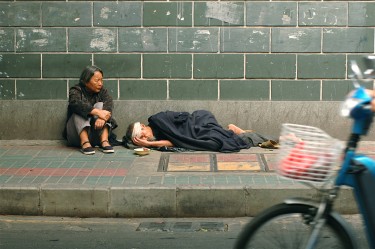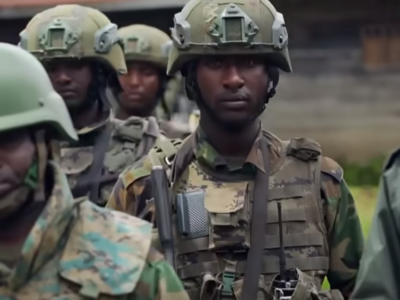This post is part of our special coverage Global Development 2011.
China has decided to raise its poverty line to RMB 2,300 yuan (approximately USD 360) per capita annual income; the population below the poverty line will be raised from 26.88 million to 130 million accordingly.
Premier Wen Jiabao has stressed [zh] that the adjustment is to include more people in the country's poverty relief scheme. However, does the new poverty line reflect the reality of China's poor?
Poverty defined by policy
The World Bank has defined extreme poverty as living on less than USD 1.25 a day, and moderate poverty as less than USD 2 a day, since 2008.

A Guizhou family making their living on a landfill site in Jiangsu. Image by Flickr user sheilaz413 (CC: BY-SA).
Given China is among the ‘Big Four‘ (BRIC) countries in the developing world, the new poverty line of USD 0.99 a day, is considered far below the international standards.
Yahoo China has prepared a special feature [zh] to address the issue, which rightly points out that the current poverty line drawn by the Chinese government is based on the daily caloric intake per capita. In addition, the line is drawn by the government poverty relief policy rather than being a reflection of people's livelihoods:
我们国家现有的贫困线,更多是一种“扶贫线”。换言之,从最低收入人群算起,国家财力能够承担扶贫到哪条线,就以此作为我们国内的贫困线——这个扶贫线是扶贫能力本位的,是政府可以讨价还价的。
The current poverty line is more a decision of the “poverty relief policy”, which means a line among the lowest income social groups where the government can afford to intervene. The poverty line is guided by the government's poverty relief work and the government can make adjustments according to its political needs.
贫困线标准提高带来的不仅是穷人数量的增加,还有更多中国的扶贫资金投入。而贫困资金的发放,采取定名额分配及认定贫困县的方式。目前,中国共有592个贫困县,其认定是在1990年代完成的。这不仅造成地方与中央在资金分配方面博弈,引发腐败。
The raising of the poverty line has not only resulted in an increase of the poor population, but also an increase in poverty relief funding. The distribution of the funds comes through the 592 counties, which were defined in 1990 as poor. The decision is hence also a political negotiation between the central government and local governments in public expenditure. Sometimes corruption is involved in the process.
Most of the Chinese netizens find the figure unrealistic and are also skeptical of the government's poverty relief work, as indicated by the following comments on The Wall Street Journal's Weibo discussion thread [zh]:
不学无术的黑籽:贫困标准被随意地玩弄着……2300一年可以干嘛? (今天 13:58)
不学无术的黑籽:The poverty standard is pure manipulation… what can you do with [RMB] 2,300 annual income?
德德的吧:年纯收入2300元,合每天收入6.3元人民币,在北京不知道是否可吃碗面条,估计街头要饭的也不在此列
德德的吧:annual income RMB 2,300, which means daily income RMB 6.3 yuan. In Beijing, a bowl of noodles would cost more than that. A beggar would not fall under this poverty line.
岳_宸:一面是贫困人口食不裹腹,看不起病,上不起学;一面是有望超越日本成为世界上最大的奢侈品市场。贫富差距不断扩大越来越成为不容忽视的问题。
岳_宸:On the one hand we have the poor who are starving and can't afford medical care and education; on the other hand, we expect our luxury product market to become the greatest in the world. The income disparity problem is indispensable.
bigwooder:再穷不能穷领导,社会主义好
bigwooder:However poor we are, our leaders cannot be poor. This is the advantage of socialism.
ChaoI3:我百度了一下08年公车消费900亿元,其他的历年三公经费都查不到.我想11年三公经费一定超万亿了,那就是等于40年的扶贫补助.对此我只想说:呵呵!
ChaoI3:I searched around in Baidu [search engine] and found our that our government's annual expenditure on vehicles was RMB 90 billion in 2008. However, I could not find the exact figure on the three public expenditures [on vehicles, travel and subsistence] on the Internet. My estimation is that it must have reached trillions of yuan in the past 11 years. Such an amount is equal to 40 years of poverty relief expenses. Ha!
NOU小姐的铺子:是我们在玩数字还是数字在玩我们?
NOU小姐的铺子:Are we playing with numbers or are the numbers playing us?
USA/China comparison

Poverty in Guangzhou, China. Image by Flickr user tarotastic (CC BY 2.0).
The Chinese poverty line figure becomes more controversial when compared with its United States (US) counterpart. The US poverty line was set at USD 22,314 annual income per household in 2010, which is equal to USD 5,578.5 (RMB 35,579 yuan) annual income per capita – more than 15 times the current poverty line level set by the Chinese government.
While local media outlet, Caijing highlighted [zh] the fact that one third of children in the US is living under the poverty line, Chinese netizens are envious of America's poor:
等待是为了不再等待:美国是被贫困,我们是被中产
等待是为了不再等待:The US has been wrongly depicted as poor, while we are wrongly depicted as middle class.
哥又要人身攻击了:晕,我家属于贫困中的贫困了,完了,年收入还不到1半呢.
哥又要人身攻击了:My God, my family is poorer than the poor. Our household income is less than half of the poverty line in the US
新远峰:这是新闻呢还是说我们过的比人家幸福吗?猪狗不如的美狗和掌权着看看自己的土地上的贫穷 的人的生活。我们在于他们相比,算是赤贫,活在这个世界算是悲哀
新远峰:This piece of news is telling us that our lives are far happier than the Americans? That the bastard US government has been ignoring the poor? When compared with the US, we are in extreme poverty. How pathetic we are.
三胖子的那点小事:我要去美国当穷人……
三胖子的那点小事:I want to go to the US to become the poor….
月本-无心:按这标准,在中国月收入低于1万1人民币的四口之家都是贫困人口。那全国95%都是贫困人口了。
月本-无心:According to the US standard, in China if the household annual income is less that RMB 11,000 yuan, one should be regarded as poor. 95% of the [Chinese] nation's population are poor.
呼唤-人性:美国的贫困线标准是:年收入低于人均gdp的1/3,就是大概15000美元;中国的贫困线标准大概是人均gdp的1/30,是1500元人民币。你说谁更像社会主义?
呼唤-人性:The US poverty line is set according to 1/3 of the annual per capita GDP level, which is about USD 15,000. While in China, the poverty live had been set at 1/30 of the annual per capita GDP level, which is about RMB 1,500 yuan. Tell me, which country looks more socialist to you?
A number of Weibo users compare China and the US's economic figures to make their points about the poverty line:
小小lo [zh]:中国贫困线的横向比较:1985、2007、2009、2010、2011年贫困线分别为206、1067、1196、1500、2300元,与当年GDP比分别为24%、5.3%、4.7%、5.0%与6.8%(预期);纵向比较,2010年美国贫困线11390美元,与当年GDP比为24%。在中国,想成为贫困人口,还真不容易
小小lo [zh]:Horizontal comparison: the poverty line levels [in China] in 1985, 2007, 2009, 2010 and 2011 were 206, 1,067, 1,196, 1,500, 2,300. The ratios to the GDP per capita were 24%, 5.3%, 4.7%, 5.0% and 6.8% (expected); When compared with the US, in 2010 the poverty line was set at USD 11,390 which is equal to 24% of the GDP per capita. In China, it is very difficult to become a poor person.
老真天真:美国人贫困线每天15美元,中国人贫困线6.3元人民币,美国人贫困线是中国人的15倍。人均GDP美国人是中国人的10倍。再看美国的食品价格,其猪肉价格是中国的0.5倍、玉米、豆类价格均比中国低,平民的生活保障主要是用来生存的,很明显中国贫困人生活状态要比美国贫困人口低的多。比比就知道,谁的谁。
老真天真:The poverty line in the US is USD 15 daily per capita income, while in China, it is RMB 6.3 (USD 0.99). The US poverty standard is 15 times higher than the Chinese counterpart. While in term of per capita GDP, the US is 10 times higher than the Chinese counterpart. Let's take a look at the food price. In the US, the price of pork is half that of the Chinese counterpart. Corn and beans are cheaper than China. It is very obvious that the living standard of the poor in China is much much lower than their US counterparts.
This post is part of our special coverage Global Development 2011.









4 comments
A very good comparison.
for me the real nembers of poverty in each county is 52 milion for the us and more then 400 milion in china because its obvious that the chinese gouv does not provide us with nessesary information and i counsider the real poverty line to be less then 10 dollars a day